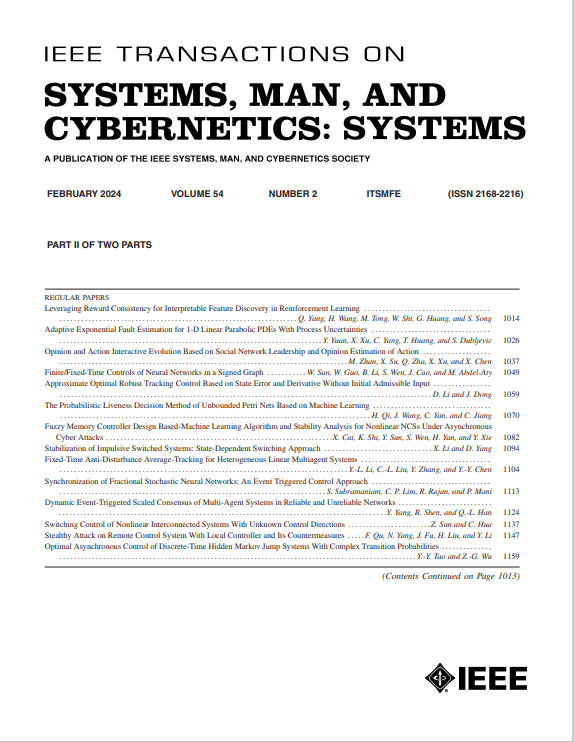欺骗攻击下网联自动驾驶车辆分散鲁棒转向的实用规定时间控制框架
IF 8.6
1区 计算机科学
Q1 AUTOMATION & CONTROL SYSTEMS
IEEE Transactions on Systems Man Cybernetics-Systems
Pub Date : 2025-04-28
DOI:10.1109/TSMC.2025.3561509
引用次数: 0
摘要
有效的车辆控制有助于互联自动驾驶汽车的安全性和效率。许多现有的解决方案没有考虑车辆之间的最大有效通信距离和方位角约束。本文提出了一种新的规定性能方法来处理距离和角度约束,以实现车辆在欺骗攻击下的稳定性。通过引入误差变换,成功地将上述两个约束由不等式约束形式转化为等效方程无约束形式,并证明了距离和角度的误差严格地包含在性能函数的边界内。另一个关键方面是利用自适应偏置径向基函数神经网络(RBFNN)对系统中的未知非线性函数和欺骗攻击进行近似,并将近似结果集成到递归构造中,设计自适应律和多车道归并控制律。分析表明,闭环系统中的所有信号都是实际规定时间稳定的。仿真结果表明,该控制方法收敛速度快于现有先进的二维飞行器控制方法,并能在不同攻击强度下自适应调整收敛到预定义集合。本文章由计算机程序翻译,如有差异,请以英文原文为准。
Practical Prescribed Time Control Framework for Decentralized Robust Steering of Connected Automated Vehicles Under Deception Attacks
Effective vehicle control contributes to the safety and efficiency of connected automated vehicles (CAVs). Many existing solutions do not consider the maximum effective communication distance and bearing angle constraints between vehicles. This article proposes a novel prescribed performance method to handle distance and angle constraints to achieve vehicle stability under deception attacks. A key aspect is that the above two constraints are successfully transformed from inequality-constrained form to equivalent equation unconstrained form through introducing error transformations, and we prove that the errors of distance and angle are strictly contained within the boundary of the performance function. Another key aspect is to use adaptive bias radial basis function neural network (RBFNN) to approximate unknown nonlinear functions and deception attacks in the system and integrate the approximated results into recursive construction to design adaptive laws and multilane merging control laws. Analysis shows that all signals in a closed-loop system are practical prescribed time stable. Simulations validate that our control method has a faster convergence time than the existing advanced two-dimensional (2-D) vehicle approach and can adaptively adjust convergence to predefined sets under different attack intensities.
求助全文
通过发布文献求助,成功后即可免费获取论文全文。
去求助
来源期刊

IEEE Transactions on Systems Man Cybernetics-Systems
AUTOMATION & CONTROL SYSTEMS-COMPUTER SCIENCE, CYBERNETICS
CiteScore
18.50
自引率
11.50%
发文量
812
审稿时长
6 months
期刊介绍:
The IEEE Transactions on Systems, Man, and Cybernetics: Systems encompasses the fields of systems engineering, covering issue formulation, analysis, and modeling throughout the systems engineering lifecycle phases. It addresses decision-making, issue interpretation, systems management, processes, and various methods such as optimization, modeling, and simulation in the development and deployment of large systems.
 求助内容:
求助内容: 应助结果提醒方式:
应助结果提醒方式:


